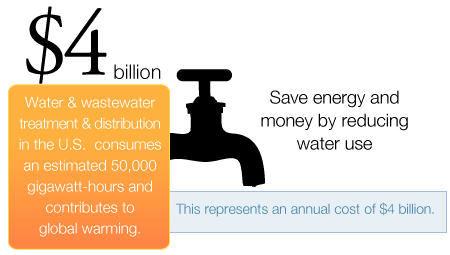City Projects in Energy Efficiency and Conservation
Water Use
Municipal water supply and wastewater treatment systems account for about 35% of energy used by municipalities.

Source: American Council for an Energy-Efficient Economy
Water and wastewater agencies rely on electricity to pump, treat and distribute water. Pumping alone accounts for 5% of the state's peak load and 7% of California's total electricity usage – high-level use that comes with a cost. As California's most significant energy users, water distribution or wastewater treatment facilities can each spend more than $500 million annually on energy, a figure that represents 50% to 75% of an agency's total costs. Click here for water conservation project examples.
To avoid the adverse effects of both rate hikes and rolling blackouts – which can have severe environmental and health impacts for the surrounding community – many water and wastewater districts have enacted conservation and efficiency measures.
Measures include adjusting operation schedules, increasing water storage, utilizing generators, optimizing cogeneration and installing efficient water system equipment, variable frequency drives and advanced equipment controls. While treatment and pumping consumes the most energy, some agencies greatly benefit by auditing and upgrading building shells, heating, ventilation, air conditioning and lighting systems. Some of these projects require a large investment in time, personnel and money, but the energy savings realized by the districts more than pays for the improvement.
Examples
(e-Newswire, 10/31/07)
(e-Newswire, 7/25/07)
(e-Newswire, 4/18/07)
Read our Local Governments Best Practices Guide for ideas on water use .


